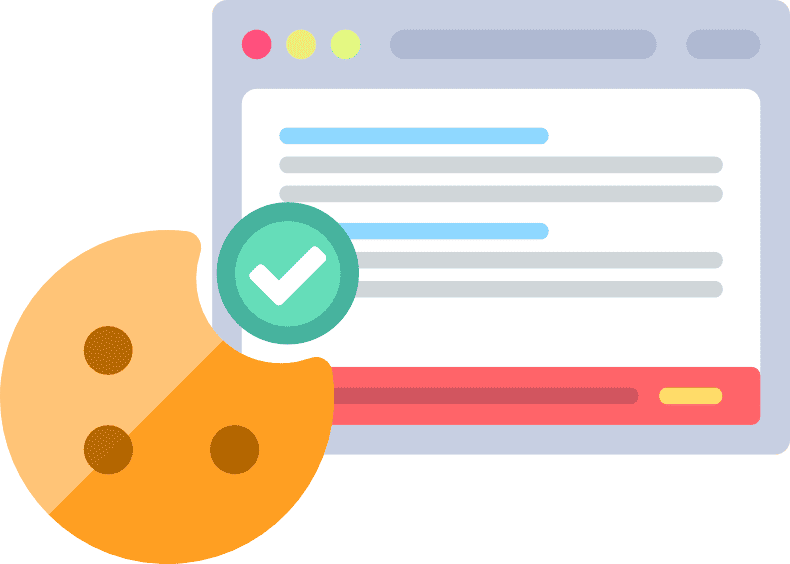Ever wonder how websites seem to know what you’ve been browsing for lately? It’s no magic trick—it’s all thanks to tracking cookies.
Essentially, cookies are small text files stored on a user’s device to help remember certain details about their visit. But there’s more to these cookies than just storing login info or saving your shopping cart.
Many are also used for tracking your browsing habits, helping businesses understand user behavior, and personalize their online experience.
As a website owner, it’s important to know what tracking cookies do, what information they collect, and the legal obligations you must follow to ensure transparency with your visitors.
In this guide, we’ll break down everything you need to know about tracking cookies and how they might be affecting your site.
- Tracking cookies help you understand user behavior, personalize content, and improve your website’s functionality.
- Data privacy laws regarding tracking cookies vary by region. Research the specific laws that apply to your target audience.
- Use a cookie banner and a clear cookie policy to inform users about tracking cookies. Offer options to accept, decline, or manage cookies to stay compliant.
Table of Contents
What Are Tracking Cookies?
Tracking cookies are a specific type of cookie used to collect data about a user’s online activity, such as the pages they visit and how long they stay on them. They help website owners understand user behavior and optimize their sites for a better user experience.
There are two main types of tracking cookies:
- First-party cookies are files set by the website a user is directly visiting;
- Third-party tracking cookies are placed by an external domain, like an ad network, to track users across multiple websites.
So, what are tracking cookies for, exactly? They’re primarily used for analytics, personalizing user experiences, and targeting ads more effectively.
In running my website, I rely on tracking cookies to see how visitors interact with my business. They give me insights into which products are getting the most attention, how often people come back, and where they might be dropping off in the buying process.
With this information, I can make smarter decisions about improving my site’s layout, tweaking the content, and making the overall experience smoother for my visitors.
Websites use cookies to track user activity and collect data that helps improve user experience, personalize content, and support marketing efforts.
How Do Tracking Cookies Work?
Tracking cookies work by exchanging information between a visitor’s web browser and the websites they visit.
When a user visits your website, their browser sends a request to your server. In response, your server sends back the website content along with cookies, if applicable. If the user’s browser is set to allow cookies, these cookies are stored on their device.
Cookies are created when your site places a small text file on the user’s device, which holds data such as the pages they visited, the time spent on your site, or actions taken. Once cookies are set, they begin tracking the user’s behavior.
Then, if they visit another website that uses the same third-party tracking cookie, the data stored in the cookie is sent to the new site. You can then use these cookies to personalize content or improve your targeted ads.
Different tracking methods are used to gather this data:
- Server-side tracking analyzes data sent by the browser directly to your server.
- Client-side tracking uses JavaScript on the user’s device to track their actions.
- Pixel tracking involves embedding small, invisible images (pixels) that track user behavior on your site.
Let me give you a tracking cookies example to help you better understand how they work. Imagine a visitor comes to your online store and adds a product to their cart but doesn’t complete the purchase.
Later, when they visit another website, they might see an ad for the product they were considering. This is because a tracking cookie placed on their device by your website’s advertising partner is tracking their behavior across different websites.
Are Tracking Cookies Legal?
Yes, tracking cookies are not illegal, but their use is subject to data privacy laws and regulations in many countries.
These laws require consent before you send cookies to your visitor’s devices. They also require websites to provide users with clear information about the types of cookies they use and how the data collected is used.
For example, this cookie consent banner from Carhartt will allow users to choose whether to accept or block tracking cookies on their browsers:
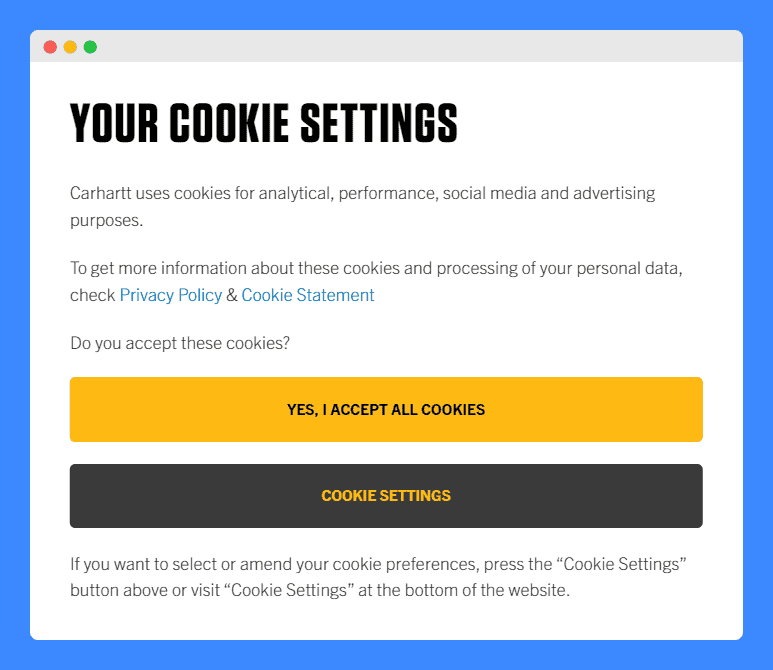
At the same time, many browsers offer cross-site tracking protection. This limits the ability of cookies to track users across different websites.
Safari and Firefox block all third-party cookies by default, making it harder for third-party advertisers to track users without their permission.
What Information Do Tracking Cookies Collect?
Tracking cookies can collect a wide range of information about your users, including their IP address, browser type, operating system, referring website, and browsing history.
Here are some of the specific types of data that tracking cookies typically collect:
- IP Address: This unique numerical label identifies a device connected to the internet, allowing you to pinpoint the general location of the user.
- Browser Type and Version: Knowing which browsers your users prefer helps tailor your site for better compatibility and optimize their experience.
- Operating System: By identifying the operating systems in use, you can ensure your site functions smoothly across different platforms and address any compatibility concerns.
- Referring Website: Understanding where users are coming from helps track which marketing channels are driving traffic to your site.
- Browsing History: Cookies can track a user’s activity across multiple websites, allowing you to use the data collected for better content recommendations and personalized ads.
- Preferences: Cookies store user preferences, such as language settings or product categories, making return visits more seamless and user-friendly.
- Login Details: Cookies can remember login information, allowing users to stay logged in and improving their overall experience on your site.
It’s important to note that personal information collected via tracking cookies can vary depending on the specific types of cookies used on a website and the purposes for which they are used.
While they can collect a lot of personal data, they do not typically collect personally identifiable information (PII). However, in some cases, tracking cookies can be used to indirectly identify individuals, especially when combined with other data sources.
PRO TIP: Have a clear privacy policy and cookie banner that explains what data is collected and how they can manage preferences. Doing this also helps you comply with data privacy laws.
How Are Tracking Cookies Used?
Tracking cookies are used to track various behaviors, from browsing patterns to purchase history. This data can then be used for a variety of purposes, including:
Ad Targeting
A common use of advertising tracking cookies is to show users ads that match their interests based on their browsing history. These cookies follow users across different websites, helping businesses show ads that feel more relevant.
Think about it. By understanding what your visitors are looking at online, you can target the right people with ads that will catch their attention. This can help boost sales and prevent you from wasting money on ads that don’t connect with the right audience.
Using tracking cookies for retargeting also keeps your products in front of users, reminding them of what they viewed but didn’t buy.
Social Media Integration
The use of cookies also applies to social media platforms. Cookies track how users interact with social media buttons on your site, like shares or likes.
This data helps you better understand which content your audience finds engaging. You can use this information to adjust your social media strategy—posting more of the content that gets interaction.
Cookies also allow you to show social media ads based on what users have done on your website. For example, if someone browses your product, they might see an ad for it on their feed. This keeps your business in their mind and can lead to more sales.
And these tactics work! In a recent 2024 survey, 83% of marketers said social media helped them get more exposure, 73% saw a boost in traffic, and 65% said it led to more leads.
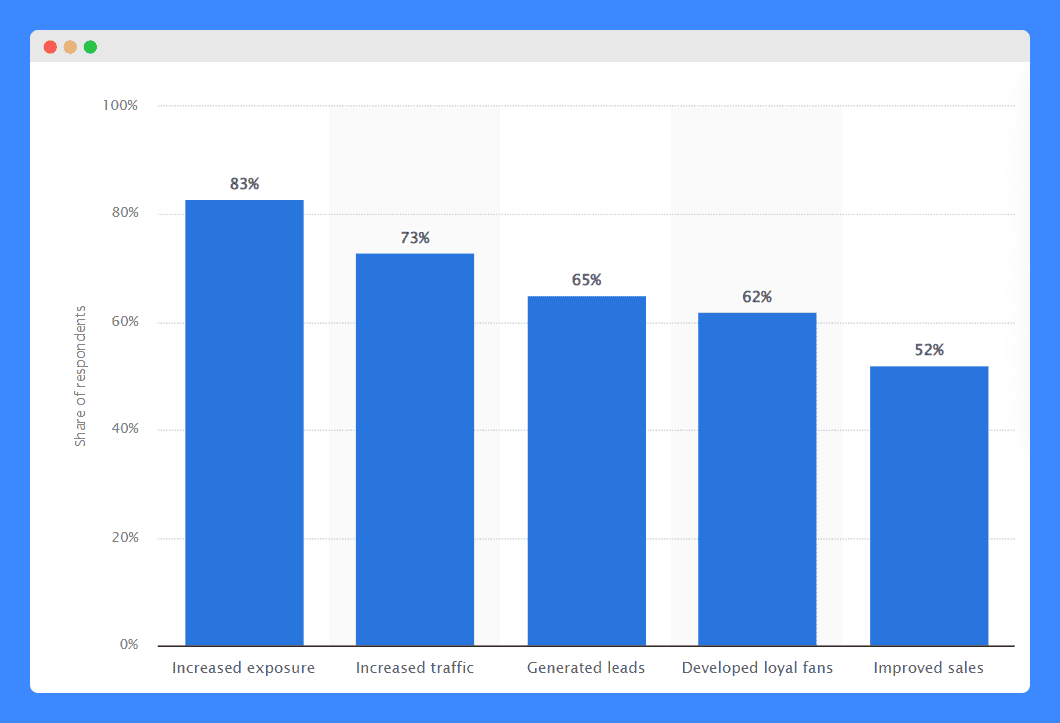
So, cookies aren’t just helpful—they can really grow your business.
E-Commerce Personalization
In e-commerce, cookies are used to track user behavior, like which products they browse or add to their carts. This helps use cookies to improve the shopping experience with personalized recommendations, reminders and offers tailored to each user.
As an online store owner, I use this strategy myself. For example, if someone abandons their cart, I send a reminder or a discount to encourage them to complete the purchase.
To make the most of this, I set up automated emails or personalized product suggestions on my website. I also use cookies to create targeted promotions, showing users relevant deals based on their shopping history.
Analytics and User Behavior Tracking
Cookies track the way visitors navigate your website, gathering insights like which pages they frequent, how long they stay, and what they click on. This data paints a clear picture of how users engage with your content.
By analyzing these patterns, you can identify opportunities for improvement. For example, if users consistently leave certain pages quickly, it may be time to rethink the layout or content.
Consider using tools like Google Analytics to dive deeper into the numbers. You can track specific metrics, such as:
- Bounce Rate: This shows the percentage of users who leave your site after viewing just one page. A high bounce rate might mean your landing page isn’t engaging enough or users aren’t finding what they’re looking for.
- Session Duration: This tells you how long users are staying on your site. Longer sessions suggest that visitors find your content useful, while shorter sessions could mean they aren’t connecting with what you offer.
- Pages Per Session: This tracks how many pages a user visits during one session. More pages per session can indicate that your content is engaging and users are exploring more of your site.
- Traffic Sources: This reveals where your visitors are coming from (direct traffic, organic search, social media, or referrals from other websites). This helps you identify which channels drive traffic and where to focus your marketing efforts.
- Exit Pages: This shows the last page a user visits before leaving your site. If you notice a specific exit page has a high rate, it might need better content or a clearer call-to-action to keep users engaged.
These insights let you fine-tune your website’s design and functionality. In turn, it will be easier for users to find what they need, which can ultimately lead to more conversions and higher engagement.
Content Personalization
Tracking cookies can help you create a more personalized and engaging experience for your website visitors by tailoring the content you show them based on their interests and preferences. You can:
- Recommend products or services they might be interested in based on their browsing history
- Display different content on a user’s homepage based on their interests or past behavior
- Send personalized emails to users depending on their interests and behavior on your website
By using tracking cookies for content personalization, you can make your website more relevant and engaging for your users. This can lead to increased user engagement, higher conversion rates, and improved customer loyalty.
Retargeting Campaigns
Tracking cookies don’t just allow basic retargeting—they help you create more segmented campaigns. Instead of showing the same ad to everyone who visited your site, you can use tracking data to target users based on their specific actions.
For example, if a user viewed a product but didn’t buy it, you can show them a tailored ad featuring a limited-time discount for that item. Or, if they abandoned their cart, your ad could remind them of the exact items left behind.
To go even further, you can use tracking cookies to segment your audience based on how far along they were in the buying process, showing different ads to those who just browsed versus those who nearly completed a purchase.
Are Tracking Cookies Compliant With Data Privacy Laws?
Yes, tracking cookies can be compliant with data privacy laws, but only if websites follow the specific regulations in their region. Here are some key laws and regulations that outline how businesses should manage the use of tracking cookies:
EU Cookie Law
The EU Cookie Law, also known as the ePrivacy Directive, regulates how websites use cookies, including tracking cookies.
Under this law, if your website has visitors from the EU, you must obtain clear and informed consent before placing any non-essential cookies, such as tracking cookies, on a user’s device.
To comply with this law, you need to:
- Provide users with a clear option to accept or decline the use of tracking cookies;
- Clearly explain what the cookies will be used for, such as tracking behavior for analytics or advertising; and
- Ensure users can easily change their cookie preferences or withdraw consent at any time.
A compliant cookie banner or pop-up is an easy way to meet these requirements. Here’s an example of one from Peloton that gives users the ability to accept or reject cookies before they are placed:

PRO TIP: Use a cookie banner generator to easily create a compliant banner for your website. It ensures you’re following data privacy laws while giving users control over their cookie preferences.
GDPR
The General Data Protection Regulation or GDPR is a comprehensive data privacy law that applies to any business handling personal data or EU residents, even if the business is outside the EU. This includes the use of tracking cookies.
Under the tracking cookies GDPR guidelines, cookies that collect personal data require explicit consent from users. This means that users must opt-in to the use of cookies. You can’t assume consent through pre-checked boxes.
Let’s look at this cookie banner example from Waterdrop, which I think violates the GDPR:
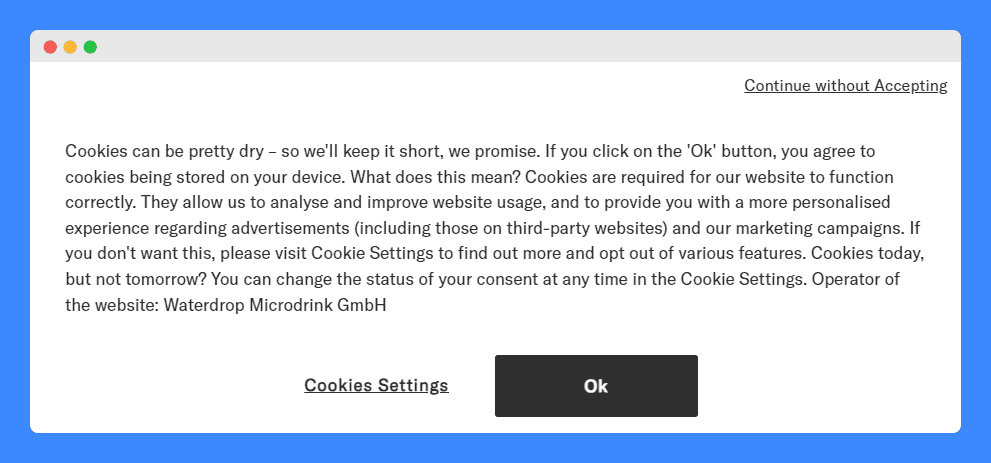
Firstly, it does not provide a clear and easily understandable option for users to block all cookies. While they can access the “Cookies Settings” to manage their preferences, this may not be immediately obvious to all users.
Secondly, although the banner doesn’t explicitly pre-tick the “OK” button, there is a risk that users might inadvertently click on it without fully understanding the consequences. This could be seen as a form of pre-ticking, which is prohibited under the GDPR.
CCPA
Any business that collects personal information from California users through means like tracking cookies, regardless of where the business is located, must comply with the California Consumer Privacy Act or CCPA.
It doesn’t require opt-in consent like the GDPR, but it gives California users specific rights over their data:
- The Right to Know: Users must be informed what data is being collected about them, including data from cookies like browsing behavior and preferences.
- The Right to Opt Out: Users can choose to opt out of the sale or sharing of their personal data. For example, if your website uses third-party cookies tracking for targeted ads, you need to give users an easy way to opt-out, often through a “Do Not Sell or Share My Personal Information” link.
- The Right to Delete: California users can request that you delete any personal data collected about them.
- The Right to Non-Discrimination: Users who exercise their privacy rights under the CCPA cannot be denied services or charged different prices because they chose to opt out of tracking.
Essentially, it’s all about giving users control. You don’t need to automatically block third-party cookies, but you must let them opt out of their data being used for specific purposes, like advertising.
LGPD
Similar to Europe’s GDPR and ePrivacy Directive, the Lei Geral de Proteção de Dados (LGPD) is Brazil’s data protection law.
Basically, it states that if your site gets traffic from Brazil, you need to be upfront about how you’re using cookies. You also need to get clear and informed consent before you place any non-essential cookies.
Under LGPD, consent must be given in writing or by other means that demonstrate the user’s intent to allow the collection of their data. For online businesses, this can be achieved by requiring users to click an “Accept” button on a cookie banner.
PRO TIP: Aside from allowing users to opt in, keep a record of when and how that consent was given. You can do this by timestamping consent or using software that tracks user preferences.
POPIA
The Protection of Personal Information Act (POPIA) is a South African law that protects the personal information of its residents. As long as you collect data from users in South Africa, this law applies to you regardless of where your business is located.
Unlike some other laws, POPIA places heavy importance on user-friendly consent and continuous transparency. World-renowned shapewear brand, Spanx, does this very well in its cookie management plugin:
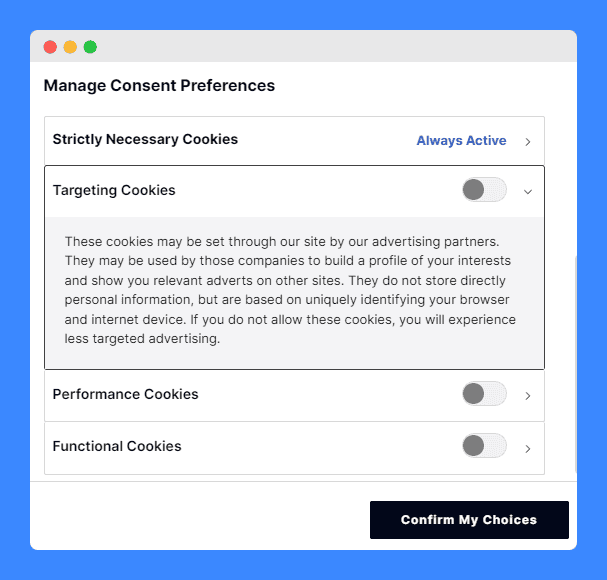
Rather than just offering an “Accept” button, it makes sure users fully understand what they are agreeing to by describing the different types of cookies they use.
PIPL
The Personal Information Protection Law (PIPL) is China’s rigorous response to data protection, applying to all businesses that process the personal data of individuals in China, including through tracking cookies.
PIPL mandates explicit consent and detailed disclosure about the use of tracking cookies. This means you must clearly inform users about what data is collected, how it is used, and whether it is shared or transferred.
Given that a 2023 survey revealed over a third of Chinese internet users use ad blockers, and one in five are wary of data misuse, compliance is not just legal—it’s critical to user trust.
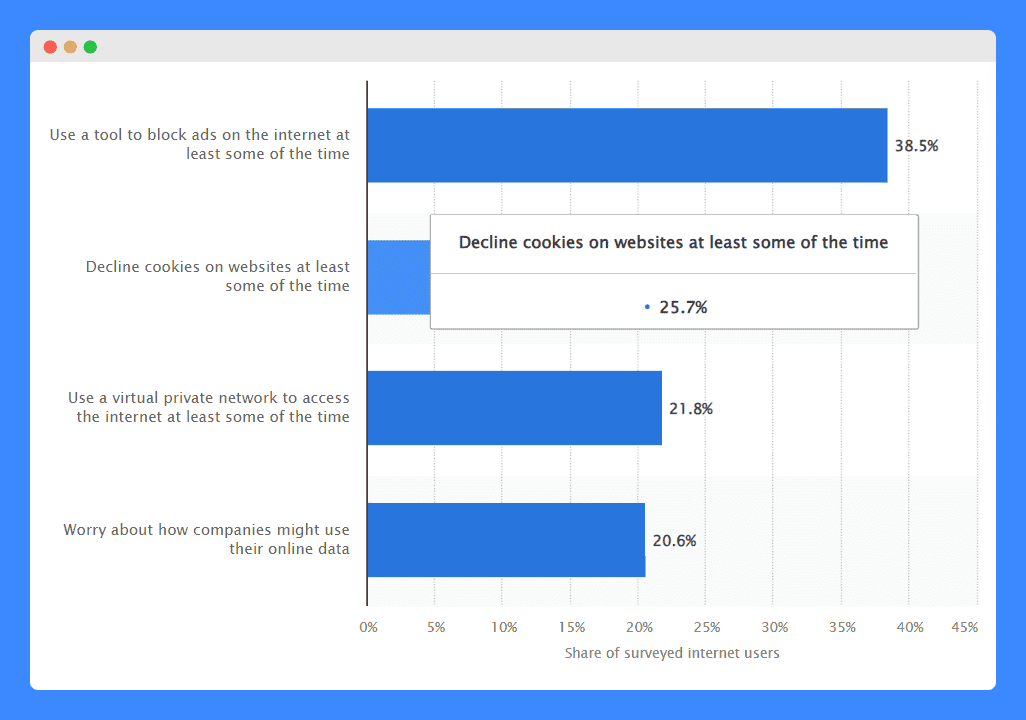
To address these concerns, you must:
- Explain the purpose of cookies in detail
- Allow users to choose which cookies they accept
- Ensure users can easily withdraw consent
- Consider local storage to comply with PIPL
It’s also important to note that while PIPL’s requirements may seem similar to other data privacy laws, there are some nuances that businesses should be aware of.
For example, PIPL emphasizes the importance of data minimization, which means that businesses should only collect and process the personal information that is necessary for their purposes.
PIPEDA
The Personal Information Protection and Electronic Documents Act (PIPEDA) governs how businesses in Canada handle personal data, including information collected through tracking cookies.
What sets it apart is its emphasis on reasonable purposes for data collection and use. While many laws require consent, it specifically require that any data collection must have a legitimate business purpose that a user would reasonably expect.
For example, using cookies to improve site functionality is typically acceptable, but tracking user behavior for unrelated third-party advertising might not meet this expectation without clear consent.
I recommend including a guide in your cookie policy explaining how users can delete cookies or disable third-party tracking cookies. Give instructions on how to manage cookies in Chrome and even link to Google Chrome Help so users can easily follow along if they need assistance.
When using tracking cookies under PIPEDA, be clear about the purpose of the cookies. Your use of them must also align with what a user would reasonably expect.
COPPA
The Children’s Online Privacy Protection Act (COPPA) is a U.S. law designed to protect the privacy of children under 13. It applies to websites, apps, and online services that are directed toward children or knowingly collect data from children under 13.
COPPA places strict limits on the use of tracking cookies for websites and services that cater to children. Here are things you need to know about this law:
- You must obtain verifiable parental consent before collecting any personal information.
- COPPA generally prohibits the use of tracking cookies for behavioral advertising. Even with parental consent, using cookies to track children’s online behavior for ad targeting is heavily restricted and often discouraged.
- Websites must limit data collection to what is necessary for providing the service. Using tracking cookies to collect more data than required for basic functionality can lead to non-compliance.
PRO TIP: If your website targets children, it’s best to disable tracking cookies entirely. Instead, focus on functional cookies that don’t collect personal data or use anonymized data.
How Do You Know if Your Website Uses Tracking Cookies?
Here’s how you can find out the types of tracking cookies on your website:
1. Inspect Cookies in Your Browser
In the Google Chrome browser, access the cookie information by clicking the lock icon next to the URL and selecting “Cookies.” This will show you a list of cookies in use and whether they are first-party or cross-site cookies.
2. Analyze Using Developer Tools
To get deeper insights, you can use the browser setting in Chrome’s Developer Tools. Open the Google Chrome browser, right-click anywhere on the page, select “Inspect,” and go to the “Application” tab.
From there, you can view all cookies, including the specific types of the existing cookies on your website. This will also help identify whether cross-site cookies are usually present for things like third-party advertising.
3. Use a Cookie Scanning Tool
Several online tools can scan your website for cookies and provide detailed reports. These tools can show you exactly which cookies are tracking users and if they are first-party tracking cookies or third-party.
How Do You Obtain Tracking Cookies Consent for Your Website?
To obtain tracking cookies consent, use a cookie banner that clearly explains why you’re setting cookies. Offer options like “Accept” and “Decline” to give users full control. Additionally, you want to:
- Make sure they understand what they’re agreeing to by adding a link to a detailed cookie policy.
- Allow them to still access your website even if they decline cookies. Websites that use tracking cookies should not force users to accept cookies just to browse.
- Offer an easy-to-use cookie settings menu where users can manage their preferences. Let them decide whether to accept essential cookies while opting out of tracking cookies.
- If possible, try to limit your use of third-party cookies. Many users prefer websites that do not use third-party cookies for tracking, as this is often associated with cross-site tracking and targeted advertising.
- Explain how they can remove tracking cookies from their browser by offering a guide or linking to browser instructions.
By following these best practices, you can ensure that your website complies with data privacy laws and obtains proper consent from your users.
Frequently Asked Questions
Are tracking cookies spyware?
No, tracking cookies are not considered spyware. They collect data about user activity on websites but don’t access personal files or harm devices as spyware does.
Are tracking cookies bad or dangerous?
No, they’re not, but if misused, they can raise privacy concerns.
Is Google phasing out tracking cookies?
Yes, Google is phasing out tracking cookies. They plan to stop support for websites that allow third-party cookies in Chrome by 2025, replacing them with more privacy-focused technologies.
What will replace third-party cookies?
Privacy Sandbox will replace third-party cookies. It will allow advertisers to target groups with similar interests, rather than tracking individuals across multiple websites.
How can tracking cookies improve my website’s user experience?
Tracking cookies can improve your website’s user experience by personalizing content and remembering preferences. They help deliver recommendations, making navigation smoother for repeat visitors.

